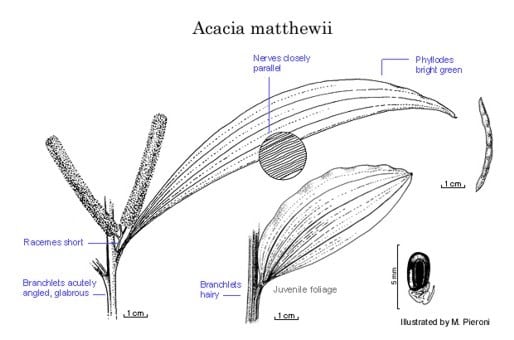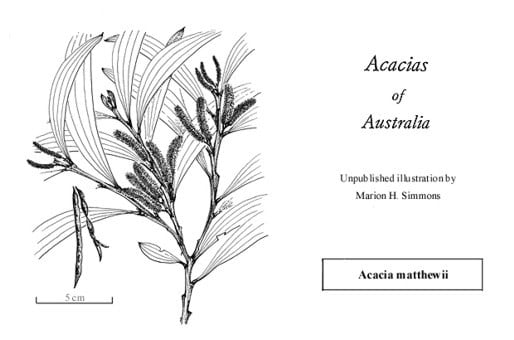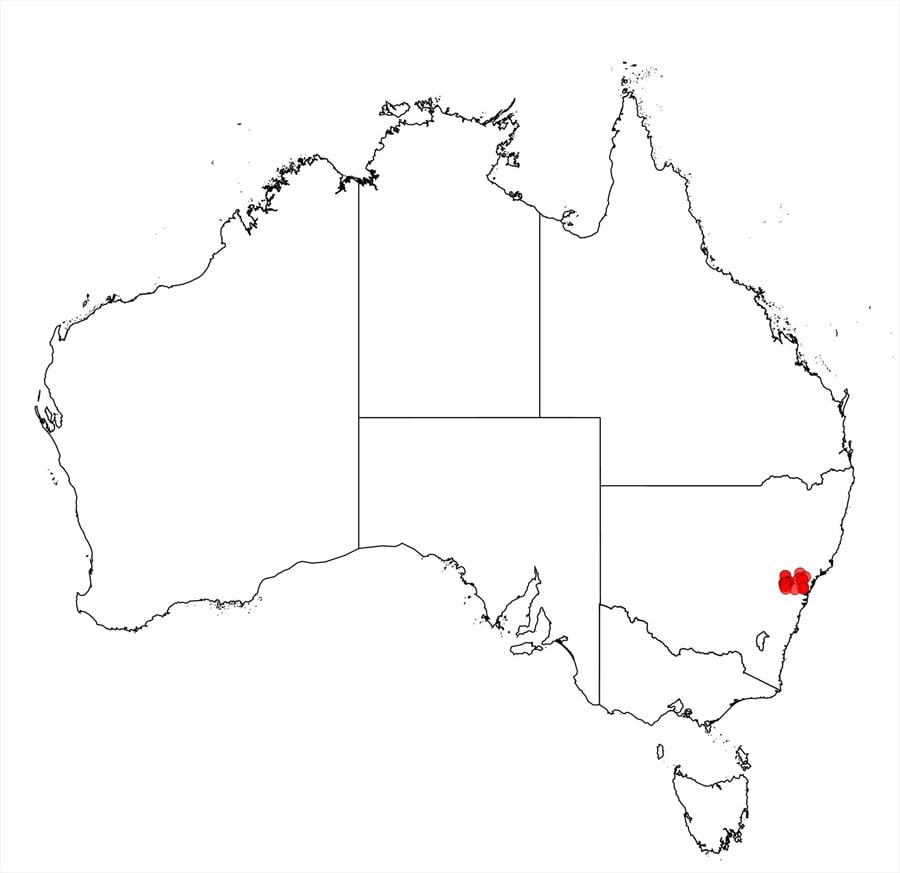Acacia matthewii Tindale & S.Davies
WATTLE
Acacias of Australia
Family
Fabaceae
Distribution
Occurs adjacent to the Hunter Valley region of N.S.W., from Rylstone, Kandos and Capertee in the west to Dharug Natl Park in the east; particularly from the area around Mt Yengo and the Howes Valley.
Description
Tall shrub or small tree, 3–15 m high, with distinct juvenile and adult foliage. Bark peeling in long thin flakes, reddish brown to grey. Branchlets markedly angular to flattened or triquetrous, light brown to reddish brown, often greenish, glabrous, scurfy; branchlets of juvenile growth ±terete and densely hairy. Mature phyllodes narrowly elliptic to very narrowly elliptic, falcate to subfalcate, (3.7–) 6–19 cm long, 9–25 (–48) mm wide, acute with subglobose mucro, subcoriaceous to coriaceous, bright green and glossy when fresh, glabrous (new growth with dark reddish resin globules and often hairy), with 3 (–5) prominent longitudinal nerves separate to base and 3–5 subprominent nerves between them; minor nerves mostly 4–6 per mm, very rarely anastomosing; basal gland inconspicuous. Inflorescences racemose; raceme axes 5–25 mm long, often growing out. Spikes 1–3, 2–6 cm long, dense, bright yellow. Flowers 5-merous; calyx 0.5–0.8 mm long, nearly truncate or dissected to 1/5, densely white-villous mainly on tube, with red-brown or black glandular hairs on apices to c. 1/2 way down; corolla 1.5–2 mm long, dissected to 1/3–1/2, with petals glabrous, scurfy on apices; ovary pubescent towards apex. Pods linear, ±flat, straight or sometimes curved, 1.7–10 cm long, 2.5–4 mm wide, coriaceous, longitudinally wrinkled, glabrous, scurfy. Seeds longitudinal, 2.8–5.3 mm long, brown to almost black, with slightly darker areole.
Phenology
Flowers Aug.–Nov.; fruits Nov.–Dec.
Habitat
Grows mostly in sandy soils on sandstone ridges, steep hillsides, and in gullies, in open eucalypt forest and margins of wet sclerophyll forest; often forming almost pure stands; sometimes on Narrabeen shale lenses.
Specimens
N.S.W.: foot of Mt Yengo, E.F.Constable 7178 (A, AD, B, BM, BRI, CANB, CHR, E, K, MO, NE, NY, PERTH, PRE, RSA, TNS, UC, UNSW, US, Z); 21 km W of Wollombi on the Mt Yengo road, R.G.Coveny 5580 & S.Jacobs (A, AD, B, BRI, CANB, K, L, MEL, NA, NSW, PERTH, RSA); 5.3 km N of Sunny Rd, Newnes Plateau, P.G.Kodela 131, P.D.Hind & C.K.Ingram (BRI, CANB, HO, NE, NSW, PERTH, SYD, UNSW); Ten Mile Hollow, Dharug Natl Park, 1 Jan. 1993, P.Matthew (CANB, MEL, NE, NSW) and M.D.Tindale, G.Clancy & P.Weston (NSW216633).
Notes
Few mature fruiting specimens of this species have been examined and there appears to be some variation in the colour and texture of the seeds. This species is a member of the ‘A. cheelii group’ and is closely related to A. cheelii and A. bulgaensis.
FOA Reference
Data derived from Flora of Australia Volumes 11A (2001), 11B (2001) and 12 (1998), products of ABRS, ©Commonwealth of Australia
Author
Minor edits by B.R.Maslin & J.Rogers
M.D.Tindale, P.G.Kodela
This identification key and fact sheets are available as a mobile application:
URL: https://apps.lucidcentral.org/wattle/
© Copyright 2018. All rights reserved.








